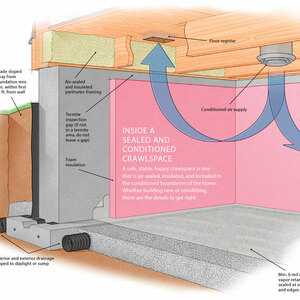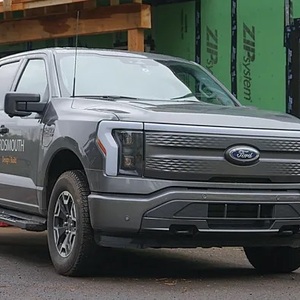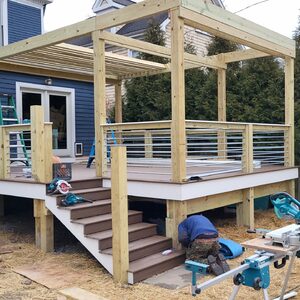*
Is there any advantage to leaving a 1″ air space between the concrete block foundation wall and the brick veneer if the veneer is built up no further than the mud sill, as opposed to leaving no space at all?
Also, what considerations, if any, need to be made if natural stone is used instead of brick? The mud sill bears on it partially, I presume it’s as strong or stronger than brick.
Thanks again for all your help.
David


















Replies
*
The air gap in a cavity wall serves two purposes:-
To stop damp penetration from outside
To ensure that condensation (if any) takes place on the inner face of the external skin, not on the inside of the wall.
To function correctly there must be a cavity tray at the bottom and weep-holes in the outer skin to drain away to the outside any water that finds its' way into the cavity.
If I understand you right, the bottom of the wall will be below ground level, therefore the weep-holes will not function, therefore there is no advantage in having a cavity wall. An exception to this would be if there is an efficient system of drainage at the foot of the wall to take away any water from the weep-holes.
As to the question of the stone versus brick, providing the crushing strength of the stone is the same as, or greater than, the brick, there will be no problem.
*Thanks for the reply Ian. You're right, the wall goes below grade. It seems to me though that without an air space the wall can, in theory, get saturated through & the inside of the wall in the crawlspace will be wet. Does this cause a problem? What happens with houses with no veneer, just solid concrete or block? Do they get damp on the inside? I'm thinking of using a ventless crawlspace with rigid insulation against the inside face of the crawlspace wall. Should I not worry?Thanks again Ian & thanks to any other replies.David
*Hi David,Yes, concrete block walls below grade (basement walls) can get saturated by underground water if the building site does not provide for adequate drainage. Blocks will become damp and you can see the dampness on the interior of the block (dark spots) as well. However, block walls that extend below grade should first be "parged" with a coating of portland cement, or painted with a portland base paint as a "waterproofer." After the parging, common practice was to use tar (which was trowled on)as a final waterproofer before backfilling.Today, instead of using tar, there are various elastomeric membranes that can be put on the wall. Some types are sprayed on. Other types are peel and stick variety, similar to the "winterguard" rubber product used as an ice dam shield for roofing. Still there are other types that are actually nailed on; these are a dimple mat type that is supposed to channel water away from the foundation wall.An easier solution is to apply tar or mastic to the wall, and then apply Dow Blueboard EPS to the walls. The tar or mastic is the glue that holds the blueboard in place. Then backfill. Putting the Blueboard on the outside, will not only act as a waterproofer, but will aid in keeping the ground temperature warmer in cold weather, and will help keep your block from condensating on the inside. Nomatter what kind of waterproofing you do to the wall, you must route any possible groundwater away from the site via the use of gutters/drains, and underground "french" drains. Do not drain your gutter system into the "French" drain lines. Run seperate lines for your gutters.You mentioned a "ventless" crawlspace wall. What are your reasons for going this route?Normally, you should put plastic sheeting (or again use Dow blueboard)on the ground and then cover this with about 2 to 4 inches of pea gravel. This will help keep moisture from rising up from the ground. Moisture always rises up from the ground, you know. By placing a few vents in your crawlspace walls, any moisture that does rise up, will have a place to escape. (Of course the opposite argument is that crawlspace openings provide moisture with a pathway to enter. Lots of pros & cons on this arguement; which is why I'm curious as to why you chose "ventless.") Concerning your brick veneer question about airspace, Ian summed it up nicely. By leaving a few weepholes in a course of bricks that are 1 to 2 courses above grade, and installing flashing (felt paper and mastic or use a rubber membrane product) behind the brick, water vapor can still escape out the wall, The flashing stops at the weephole level; else it does no good channeling the water into the subterranean level below grade.As for your above grade crawlspace wall area, you could (instead of using brick) insulate the outside with foam board, then apply mesh overtop the foam board and stucco. The stucco would be waterproof when it cures and the foam would again help to insulate your wall. You could use either "real" stucco (portland cement variety) or use acrylic stucco such as Dryvit or Stowelit. Either type should give you good results. Although nothing wrong with using brick instead.Will your concrete block cores be filled with concrete or left unfilled? Any unfilled cores should be filled with vermiculite (for insulative purposes).Good luck on your house.Davo.
*Davo,Thanks for your reply. I have read so much (this site, JLC, papers, web surfing) that I really can't remember where I got the idea that a ventless crawlspace is a good idea. I do remember reading that vents can (& will) let in loads of humid air in the summer and that inspectors no longer insist on vented crawlspaces anymore, which leads me to believe that there must be something to it - it's not just a fad. I've printed a lot of what I've found and will have to read it again. I've just started drawing the plans for my house and would like to incorporate all the best thinking and details as I know them or can find them. My mother-in-law's foundation walls don't have an airspace and the inside seems quite dry. Maybe there's not much to worry about, but if an airspace is better construction, then I'll use it. This will be an all crawlspace foundation, and again I remember that the technique is to insulate the walls from the inside with rigid foam, 6mil polythene on the ground, no insulation under the floor and a small amount of heating and/or ventilation may be required.With regard to the concrete blocks being filled or not, I was probably going to leave them unfilled. Here the underside of the footing only has to be 18" below grade. Having said that, I think I am required to have a solid row of blocks at the top of the wall. Not knowing how to install the bolts through a solid block, I was going to put wire mesh below the top course of blocks and fill from there up with concrete and casting in the bolts. If the wall is short it may be easier to just fill it all with concrete.I bought Bob Thallon's book, Guide to Frame Construction, from Taunton Press but I still find myself asking lots of questions. As on site, it should get easier when I'm "out of the ground". For the exterior walls, I think I'm going to go with Mike Smiths idea of havinf the rigid insulation on the inside with furring on top to accept the drywall. I know my biggest headache will the roof framing plan. I'll probably pay someone to advise me. Maybe I should let the roof framer handle it. Not sure yet. I used to design and draw for a living in the civil engineering, petrochemical and offshore oil industries before coming to the USA. What was drawn was exactly what built without deviation. That expectation's ingrained in me I guess as I haven't reconciled myself to letting someone build (a roof ) without a drawing. But after reading here for the last six months I've been surprised by the abilty of folks to be so knowledgeable about building science, what's the current thinking, construction details, how to do this, how to frame that, and knowledgeable enough too to be able to argue the case for their position. I'm slowly changing my mind.David
*
Is there any advantage to leaving a 1" air space between the concrete block foundation wall and the brick veneer if the veneer is built up no further than the mud sill, as opposed to leaving no space at all?
Also, what considerations, if any, need to be made if natural stone is used instead of brick? The mud sill bears on it partially, I presume it's as strong or stronger than brick.
Thanks again for all your help.
David